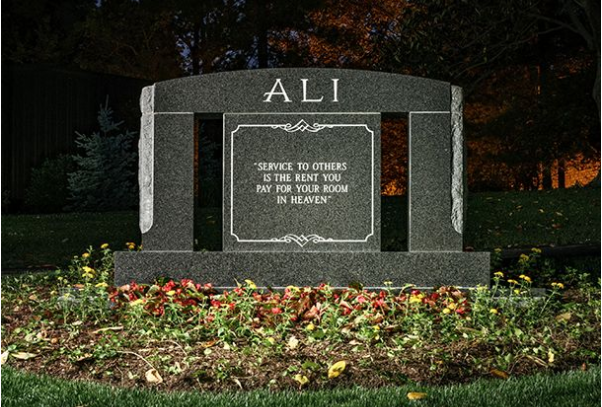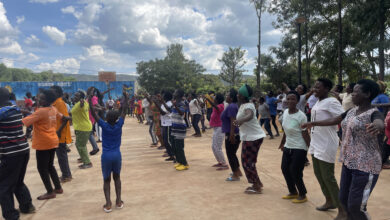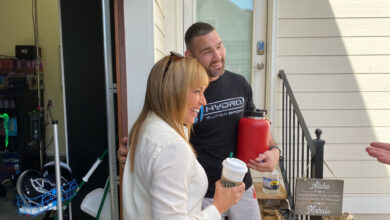ESPN’s “Journalism Showcase” – June 2, 2017

Senior writer Tom Junod notes that after visiting Muldoon Memorials in Louisville, Kentucky earlier this year, he knew he would be writing a story about the intimate details of laying Muhammad Ali to rest. “The Greatest, At Rest,” featured in ESPN The Magazine’s “World Fame 100” issue appears on newsstands today.
Can you take readers through how the story came together?
After I visited Muldoon, I proceeded directly to the office of Cave Hill Cemetery, where I met its CEO, Gwen Mooney. She arranged a group interview with key figures from the cemetery’s staff including groundskeepers, landscapers, security and administrators. There were eight people in all, sitting around a conference table telling their stories. I found out then that Lonnie had bought the cemetery plot many years before; I found out then that Will Smith and Mike Tyson had both had a hand in filling up Ali’s grave; I found out then many details of the day of his funeral that I wish I could have fit in the story even now. But more importantly, I discovered that they all felt a sense of ownership in the great labor of laying Muhammad Ali to rest, and that sense of ownership — almost of personal validation — is what propelled my research and my writing.
What was the most challenging aspect of this story?
Everyone I spoke to wanted their stories told. It was never a matter of me digging; it was a matter of them giving. They were so generous, and time after time I started interviews in the simplest way — “tell me what you did the week of Muhammad Ali’s funeral” — and then found myself turning off the tape recorder an hour and a half later, with the hair standing up on my arms. The challenge wasn’t getting people in; it was leaving them out. I did more than 30 interviews for this story, and when I first started writing, I tried to get them all in; indeed, felt a sense of duty to get them all in. I called my editor, Eric Neel, and said, “I got chills in almost every interview, and yet I’ve written nearly three thousand words, and there’s not a chill to be had.” He said, “Follow the chills.” So that’s what I did.
What do you hope readers will take away?
What moved me the most throughout the four months I worked on this story was the hunger I felt in people for a role in history, and the willingness to give themselves up to a force larger than themselves. For one week in June 2016, that force was represented by Muhammad Ali. He’d been sick for so many years; he’d gotten old, and so had the generation of people who’d been lucky enough to watch him fight. But his funeral turned out to be a global event; the biggest public funeral since those of Lady Di and Nelson Mandela. And that forced me to confront the essence of his greatness. He was not just a famous man. He was a famous man who made other people feel famous. And when he died people understood the extent to which they felt lifted by him, ennobled. His funeral was a response to his generosity; an outpouring of gratitude.
Reporter Tom Rinaldi is known for telling some of the most heartwarming stories in sports, but Draymond Green’s story is unlike those others Rinaldi has worked on.
“I absolutely loved our time with Draymond. We learned quickly that no single soundbite, as provocative as it may be could sum up who he is or his nature, at least in our time with him,” Rinaldi said. “We covered a lot of different topics from his childhood in Saginaw, Michigan to where he was drafted and the chip on his shoulder he carries to his suspension and last year’s finals against LeBron. He is somebody who would answer any question that you asked him.”
Green has certainly developed a reputation for his outspokenness, not always in the best way, but Rinaldi discovered a side of Draymond Green that many don’t know.
“One thing that we learned is that Green made the single-largest donation to Michigan State athletics in its history and he did that because of how indebted he feels to [head basketball] coach Tom Izzo and the program. That says a lot about who he is,” Rinaldi said. “We also learned when he was just a young boy he would sit on the rec center basketball court and refuse to move if players didn’t want to play with him. The older boys would throw basketballs off of his head and toss him into a garbage can but he would come back and stand his ground on the court. I think a lot of how he plays now was born from that introduction to the game.”
Rinaldi is grateful for the opportunity to be able to work on long-form pieces like this every day.
“E:60, SC Featured, Outside the Lines. . and all the storytelling platforms, it is such a privilege to be a part of these brands at ESPN,” he said. “We know that to tell stories takes resources and time. And the company’s commitment to doing long-form journalism and this brand of storytelling makes it a dream place to work.”
-By Molly Mita
- Sunday’s SC Featured segment on SportsCenter will tell the story of LSU softball player Bailey Landry, whose parents were so moved by the iconic photo of a baby named Baylee Almon, who was an Oklahoma City bombing victim, that they named their child after her. This week, as LSU plays in the Women’s College World Series in Oklahoma City, baby Baylee’s mom meets Landry’s family for the first time. “What’s In a Name?” will debut in the 10 a.m. ET edition of SportsCenter on Sunday, June 4, and re-air in other editions of the program throughout the day.
- ESPN writer Sid Lowe tells the story of how Real Madrid manager Zinedine Zidane expertly managed Cristiano Ronaldo and helped him lead the team to a historic season. The story is part of ESPN The Magazine’s “World Fame 100” issue out on newsstands today.
- FiveThirtyEight writers Morgan Jenkins and Walt Hickey discuss an issue many people deal with on a weekly basis, splitting checks. As part of the advice column on FiveThirtyEight.com, Jenkins and Hickey answer a reader’s question in the best way they know how in “How Do I Split a Check with a Bad Check Splitter?”
- With this year’s Women’s College World Series underway, espnW writer Graham Hays looks back on an historic performance by former Arizona pitcher Taryne Mowatt in the 2007 WCWS, one that saw the pitcher throw over 1,000 pitches in seven days.
- ESPN took home four awards yesterday at the ninth annual College Sports Media Awards, presented by Sports Video Group (SVG) and the National Association of Collegiate Directors of Athletics (NACDA). The event, hosted by ESPN’s Tom Rinaldi, awards the best in college sports video. ESPN and Longhorn Network were recognized for their outstanding achievements in college football, taking home two awards in each of the following categories: Outstanding Live Non-Game Production (College Football Playoff Top 25 and Texas GameDay) and Outstanding Special Feature. ESPN’s Jen Lada worked on both features— Heart of a Tiger, produced by Kristen Lappas, and Texas Fight, produced by Michael Holmes.







